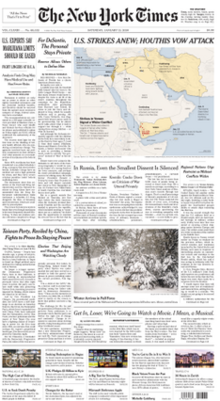The 45-Second Trick For News Articles
The 45-Second Trick For News Articles
Blog Article
The Facts About News Articles Revealed
Table of ContentsSome Ideas on News Articles You Should KnowNews Articles Fundamentals ExplainedUnknown Facts About News ArticlesThe Buzz on News ArticlesThe News Articles Statements
Great knowledge of various topics offers pupils an one-upmanship over their peers. Despite the fact that digital and social networks are easily obtainable, we must not forget just how vital it is to read the papers. Parents should attempt and instill the routine of reading a paper as a daily regimen to proceed the tradition of the adored print tool.News stories also contain at the very least one of the adhering to vital attributes relative to the intended target market: proximity, importance, timeliness, human passion, quirk, or repercussion.
Within these limitations, information tales likewise intend to be thorough. However, various other factors are involved, some stylistic and some stemmed from the media type. Among the larger and much more highly regarded newspapers, fairness and balance is a significant element in offering details. Discourse is generally constrained to a different section, though each paper might have a different overall angle.
Papers with a global audience, for instance, tend to use a much more formal style of creating. News Articles.; typical design overviews include the and the United States News Design Book.
News Articles for Beginners
As a rule, reporters will not utilize a long word when a short one will do. Information writers attempt to prevent utilizing the same word more than once in a paragraph (in some cases called an "echo" or "word mirror").
Nonetheless, headings in some cases leave out the subject (e.g., "Leaps From Watercraft, Catches in Wheel") or verb (e.g., "Pet cat lady fortunate"). A subhead (additionally subhed, sub-headline, subheading, caption, deck or dek) can be either a subservient title under the main heading, or the heading of a subsection of the short article. It is a heading that precedes the primary text, or a team of paragraphs of the primary message.

of a post subject, source, or interviewee), it is described as a drawn quotation or draw quote. Extra signboards of any of these types may appear later on in the post (specifically on subsequent pages) to entice more reading. Journalistic websites often use computer animation strategies to switch one signboard for another (e.g.
Not known Factual Statements About News Articles
Such signboards are also utilized as guidelines to the short article in other areas of the magazine or site, or as advertisements for the piece in various other publication or websites. News release of the Swiss government. Common framework with title, lead paragraph (recap in vibrant), various other paragraphs (details) and get in touch with details.

Example of a hard-lead paragraph NASA is suggesting one more space task. The budget plan requests approximately $10 billion for the project.
An "off-lead" is the 2nd most essential front page information of the day. To "bury the lead" is to start the post with background information or details of second value to the readers, forcing them to check out even more deeply into a write-up than they must have to in order to discover the crucial points.
The Greatest Guide To News Articles
Typical usage is that a person or 2 sentences each form their own paragraph. Journalists generally explain the company or framework of a newspaper article as look at more info an inverted check these guys out pyramid. The essential and most fascinating aspects of a tale are placed at the beginning, with sustaining information following in order of diminishing relevance.
It enables people to discover a subject to just the deepness that their interest takes them, and without the charge of information or subtleties that they could think about unnecessary, yet still making that information available to much more interested visitors. The inverted pyramid structure likewise allows posts to be cut to any type of approximate size throughout design, to suit the space offered.
Some authors begin their stories with the "1-2-3 lead", yet there are numerous kinds of lead available. A twist can refer to several things: The last story in the news program; a "delighted" story to finish the program.
Longer articles, such as publication cover posts and the pieces that lead the within areas of a paper, are referred to as. Feature tales vary from straight news in several means. Foremost is the lack of a straight-news lead, the majority of the moment. Rather than offering the significance of a story in advance, function authors might attempt to tempt visitors in.
Rumored Buzz on News Articles
An attribute's initial paragraphs frequently associate an intriguing moment or event, as in an "anecdotal lead". From the particulars of a person or episode, its view swiftly widens to generalizations concerning the tale's subject.

The Editor's Tool kit: A Recommendation Overview for Beginners and Professionals (2001) Allan M. Siegal and William G. Connolly. The New York Times Guidebook of Style and Use: The Official Design Overview Used by the Writers and Editors of the Globe's A lot of Authoritative Newspaper (2002) M. L. Stein, Susan Paterno, and R.
Report this page